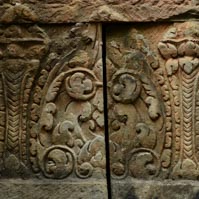
The German Ankorian Imagery Project
• G • A • I • P •
Preah Pithu (the "u" is slightly stressed) is not one single temple, but a group of five temples from different periods. They are just behind the small restaurants of the Angkor Thom main car park, very close to the frequently visited Elephant and Leper King Terraces, only at the opposite side of the road. The Preah Pithu temples are small, but really pretty, offer some fascinating details, and their location is delightful and romantical, a perfect place for strolling around. All the more surprising is: Preah Pithu is rarely visited.
The temples of Preah Pithu have been named: T or 481 (the southwestern temple, closest to the car park), U or 482 (behind T), V or 484 (further north), X or 483 (in the east), and Y or 485 (the northernmost). Temples T, U, V, and Y are dedicated to the Hindu deities. But Temple X is Buddhist. It is unfinished and probably the latest, maybe even as late as the 14th century.
T and U are surrounded by the same moat. Interestingly, they face west, just like Angkor Wat. In front of the entrance there are cruciform terraces on two levels, with Naga balustrades. T has has a 45 m long and 40 m wide enclosure, made of sandstone, which is unusual. There are two Gopurams on the main axis, the eastern one leading to the smaller structure U. The pyramidal structure of T has a chamber on the top which enshrined a large Lingam on a Yoni pedestal. Fragments of the lintel of the western door are on the ground now, they show a stylized depiction of the common motif "Churning of the Milk Ocean". The walls are decorated with Devata goddesses in the Bayon style, with floral ornaments on their skirts.
U is quite similar to T, only smaller and simpler. Its enclosure is 35 by 28 metres without Gopuram. The lintel of west door shows the Trimurti Brahma-Vishnu-Shiva, but emphasizing Shiva in the centre, he is dancing on a Kala-masque.
The Buddhist Temple X to the east stands on a 4 m high terrace. Its decoration is incomplete. The laterite terrace is surrounded by stelae called Bai Semas, they are delimiting the consecrated area according to the rules laid down in the Vinaya Pitaka, which is the first part of the Buddhist Holy Scriptures. Four axial stairways guarded by lions give access to the sanctuary. The most remarkable feature of temple X is the double panel of Buddha sculptures inside the sanctuary.
Temple V is north-east of X. It has a 70 m long causeway from the west, but the main entrance is from the east. The sanctuary of V is the largest of the Preah Pithu group. It shelters a huge Lingam, 1.5 m high. Its wall decorations are in the Angkor Wat style, but not completed. Next to the east entrance is a stele depicting ocean-god Varuna on his mount Hamsa, the sacred geese.
Temple Y, just north of V, stands on an earthen mound. It was built slightly later than V. Its structure is different from that of the other Preah Pithu temples. It has an elongated Mandapa in front of the central sanctuary. On the western side there are remarkab
Ernst Ando Sundermann
• G • A • I • P •
Copyright © 2021 khmer-heritage.de